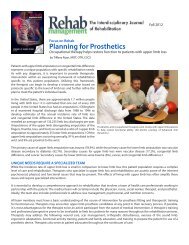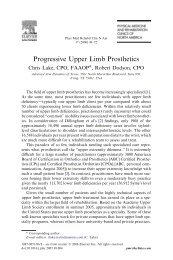Prosthetic Advances - Zach T. Harvey, CPO - Advanced Arm Dynamics
Prosthetic Advances - Zach T. Harvey, CPO - Advanced Arm Dynamics
Prosthetic Advances - Zach T. Harvey, CPO - Advanced Arm Dynamics
Create successful ePaper yourself
Turn your PDF publications into a flip-book with our unique Google optimized e-Paper software.
FIGURE 3 Targetted Muscle Reinnervation is a surgical procedure<br />
intended to improve the ability for the user to control the movements<br />
of the prosthesis. As surgical techniques continue to advance, more<br />
sophisticated prosthetic devices will be possible to operate. Photo<br />
courtesy of <strong>Advanced</strong> <strong>Arm</strong> <strong>Dynamics</strong>, Redondo Beach, CA.<br />
Targeted muscle reinnervation (TMR) is a novel amputation<br />
revision procedure, developed by Kuiken and Dumanian<br />
(46–49) wherein motor nerves whose primary<br />
target muscle groups have been lost are re-implanted into<br />
deliberately dennervated proximal muscles (Fig. 3). This<br />
produces an increased number of independent control sites<br />
for myoelectric prostheses, which can then be myoelectrically<br />
coupled with actions that are intuitively associated<br />
with the specific nerve(s). The result is the ability to simultaneously,<br />
rather than sequentially, manipulate multiple<br />
joints or devices and perform multiple prosthetic actions<br />
instinctively. At present, the procedure is most useful for<br />
proximal levels such as transhumeral amputations and<br />
shoulder disarticulations, and is usually performed as a<br />
delayed revision procedure, although acute TMR may<br />
prove feasible in the near future.<br />
<strong>Advanced</strong> pattern recognition (APR) refers to the use<br />
of computer algorithms to decipher surface electrode data<br />
and subsequently associate specific signal patterns with<br />
the appropriate prosthesis response for patients who have<br />
undergone TMR (47). For example, the patient repetitively<br />
thinks about closing his hand, and the electrode<br />
signals associated with this action are then programmed<br />
into the myoelectic prosthesis to generate the desired<br />
response. This permits even more rapid, intuitive, and fluid<br />
device control. Early results of both techniques have been<br />
promising.<br />
Additionally, a number of new implantable electrodes<br />
have been developed to improve myoelectric device<br />
control. These most commonly amplify peripheral nerve<br />
signals and thus improve the prosthesis responsiveness<br />
via a more reliable neuromuscular unit-prosthesis interface<br />
and/or permit the reception of signals from individual<br />
muscle groups, allowing more precise prosthesis control<br />
(50–56). Prototype electrodes designed for intracranial<br />
implantation have also been developed to permit myoelectric<br />
prosthesis control directly via signals transmitted from<br />
the cortical homunculous (50,57–59).<br />
Upper extremity prosthetic advances<br />
Upper extremity prosthetics devices have made profound<br />
advancements in recent years. There have been<br />
new surgical advancements in upper extremity amputation<br />
techniques and residual limb-prosthesis interfaces<br />
and several advancements in upper extremity prosthetic<br />
components.<br />
One of the greatest challenges with upper extremity<br />
prosthetics has been patient acceptance. Recent studies<br />
have found higher replacement and use rates and lower<br />
abandonment rates of upper extremity prostheses among<br />
Operation Enduring Freedom (OEF) and Operation Iraqi<br />
Freedom (OIF) combat-wounded service members compared<br />
to those from the Vietnam era (60,61). A higher<br />
acceptance rate amongst wounded warriors from OEF/OIF<br />
can be attributed to several factors including improved<br />
technology for upper extremity prostheses (60), increased<br />
rehabilitation and occupational therapy time, and a general<br />
cultural acceptance of a blending between man and<br />
machine. New terms have risen in modern culture to<br />
describe the blend of man and machine such as “cyborg”<br />
and “bionic.” Although myoelectric prosthesis have been<br />
available since the 1960’s and early 1970’s, most patients<br />
fit with upper extremity devices in the civilian world have<br />
used body-powered prosthetic devices. With advancements<br />
in surgical techniques, new requirements will<br />
become commonplace amongst upper extremity components.<br />
In the past, myoelectric prostheses would have<br />
to be controlled sequentially, i.e. flex elbow-lock elbow,<br />
rotate wrist–open hand-close hand. Work is being done<br />
to combine these actions into simultaneous control with<br />
all actions, or at least multiple actions, taking place at the<br />
same time. This increased simultaneous control will allow<br />
the upper extremity prosthesis to function faster and more<br />
efficiently.<br />
As a result of cooperative of government initiatives<br />
and investment, such as the Defense <strong>Advanced</strong> Research<br />
Projects Agency funding, educational research programs,<br />
and private industry interests, there have been promising<br />
recent advances in upper extremity prosthetics. Recent<br />
work includes development of prosthetic arms that have<br />
more degrees of freedom than current technology; some<br />
experimental prostheses have up to 27 degrees of<br />
freedom (15).<br />
Several manufacturers are developing externally powered,<br />
microprocessor TMR-compatable elbows (Otto<br />
Bock TMR Dynamic <strong>Arm</strong>, Motion Control Utah TMR,<br />
and the Boston TMR) for use with multiple simultaneous<br />
Copyright © 2012 by the Southern Orthopaedic Association VOLUME 21, NUMBER 1, SPRING 2012 61










